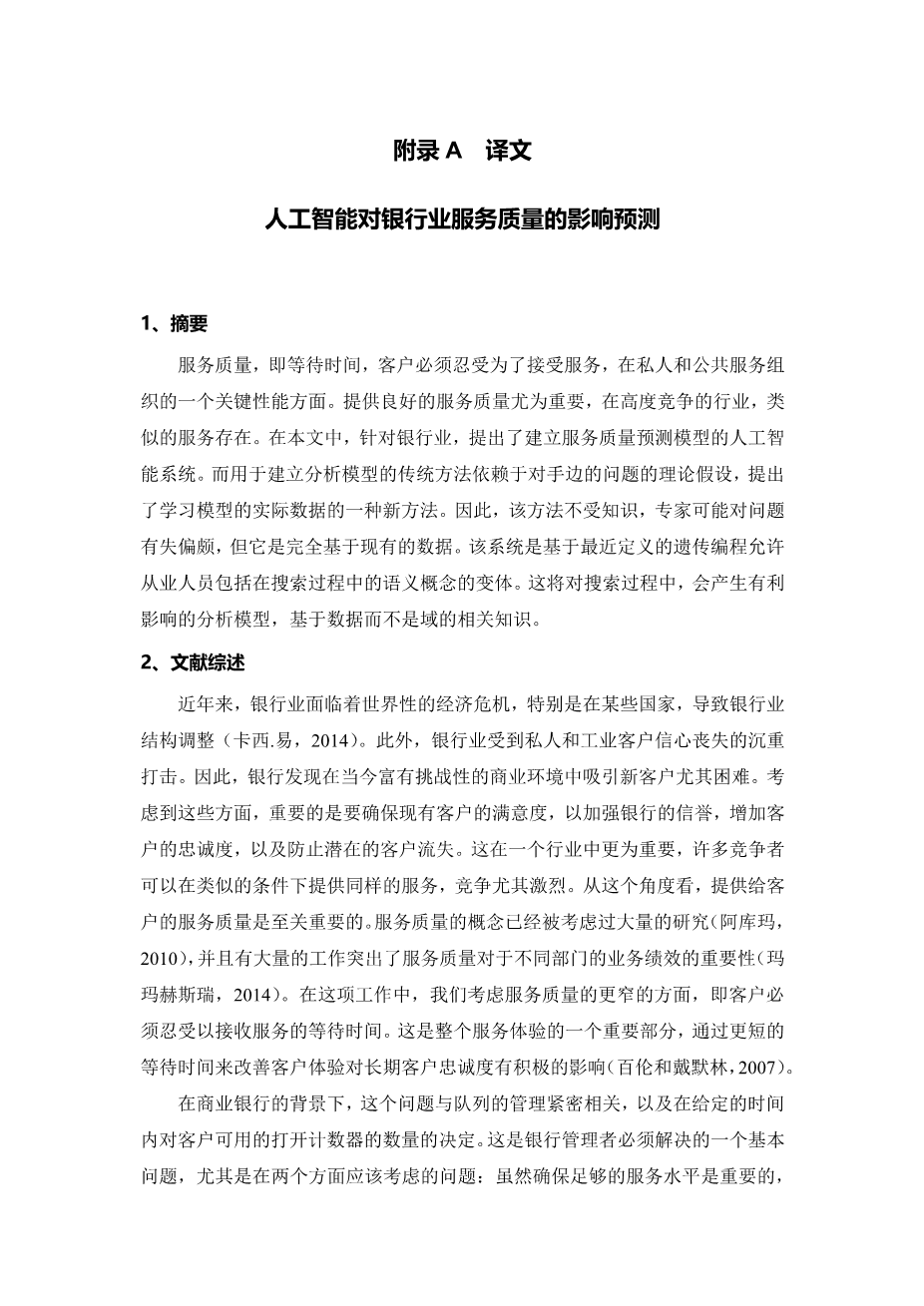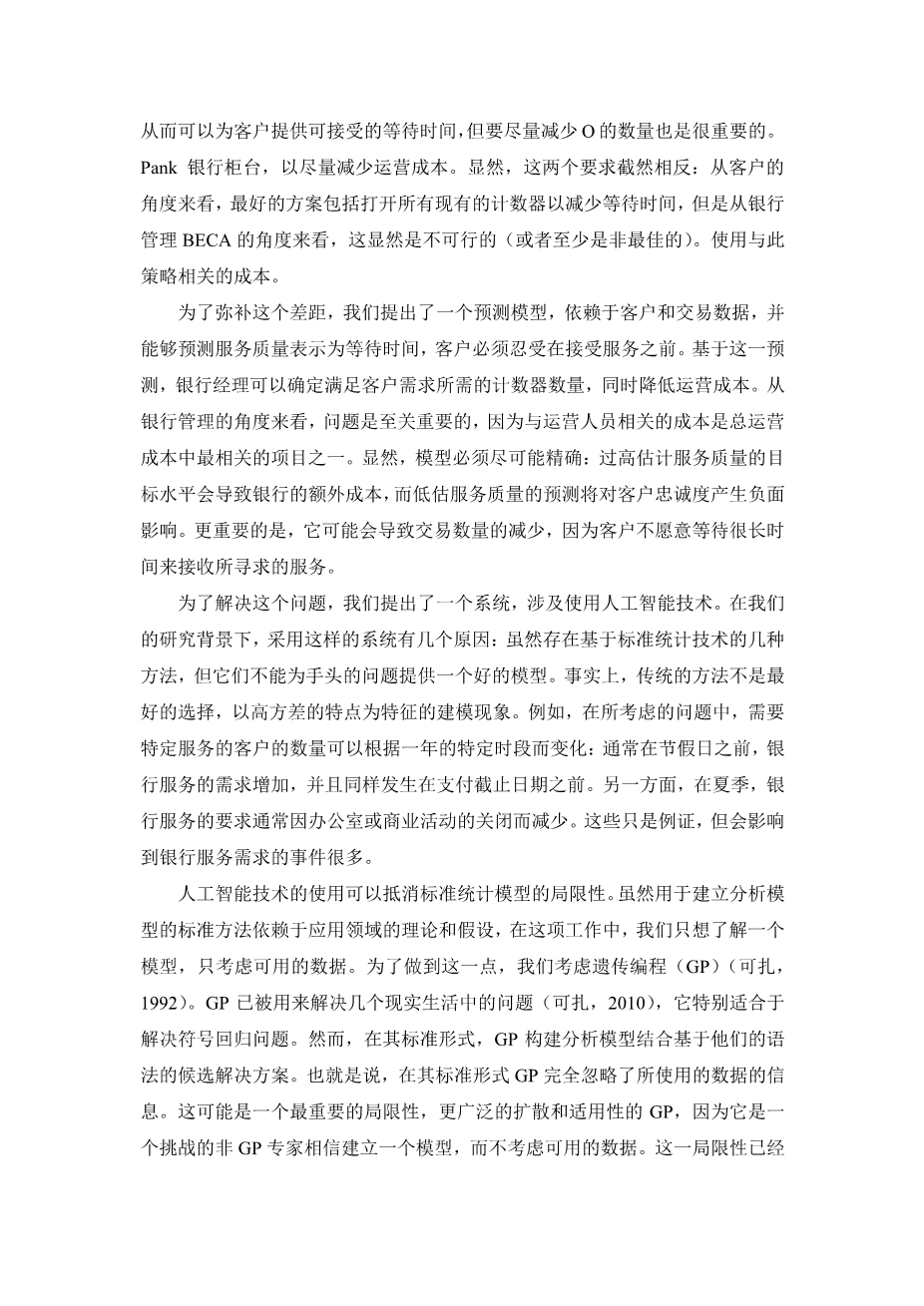Prediction of the impact of AI on banking service quality
1、Abstract
Quality of service, that is, the waiting time that customers must endure in order to receive a service, is a critical performance aspect in private and public service organizations. Providing good service quality is particularly important in highly competitive sectors where similar services exist. In this paper, focusing on banking sector, we propose an artificial intelligence system for building a model for the prediction of service quality. While the traditional approach used for building analytical models relies on theories and assumptions about the problem at hand, we propose a novel approach for learning models from actual data. Thus, the proposed approach is not biased by the knowledge that experts may have about the problem, but it is completely based on the available data. The system is based on a recently defined variant of genetic programming that allows practitioners to include the concept of semantics in the search process. This will have beneficial effects on the search process and will produce analytical models that are based only on the data and not on domain-dependent knowledge.
2、Journals reviewed
In recent years, the banking sector has faced a world-wide economic crisis that has led, especially in certain countries, to a restructuring of the banking industry (E.Casey,2014). In addition, the banking sector has been heavily hit by loss of confidence by both private and industrial customers. Thus, banks find it particularly difficult to attract new customers in today’s challenging business environments. Considering these aspects,it is essential to ensure the satisfaction of existing customers in order to strengthen the credibility of the bank,to increase the loyalty of the customers, as well as preventing potential customer attrition. This is even more important in a sector where many competitors can offer the same services at similar conditions and where competition is particularly strong. Under this perspective, the quality of service provided to the customers is crucial. The concept of quality of service has been considered in a plethora of studies (S. Arun Kumar,2010)and there is a large amount of work highlighting the importance of service quality for business performance in different sectors (J. Umamaheswari,2014). In this work we consider a narrower aspect of service quality, namely, the waiting time that customers must endure in order to receive a service. This is an important part of the overall service experience as improving the customer experience through shorter waiting times has positive effects on long-term customer loyalty (F. Bielen and N. Demoulin,2007).
In the context of a commercial bank, this issue is tightly linked to the management of the queues and the decision about the number of opened counters available to customers at a given time. This is a fundamental problem that bank managers must address and, in particular, the problem should be considered under two aspects: while it is important to ensure an adequate level of service that results in acceptable waiting times for customers, it is also important to minimize the number of opened bank counters in order to minimize operating costs. Obviously, the two requirements are diametrically opposed: from the point of view of the customer the best scenario involves opening all the existing counters in order to reduce waiting times, but this is clearly infeasible (or at least nonoptimal) from the point of view of the bank management because of the cost associated with this policy.
To bridge this gap, we propose a predictive model that relies on customer and transaction data and is able to predict the quality of service expressed as the waiting time that customers must endure before receiving a service. Based on this prediction, it will be possible for the bank managers to determine the number of counters required to satisfy customer demands while minimizing operating costs. The problem is of fundamental importance from the point of view of bank management as the cost associated with operating personnel is one of the most relevant items for the total operational costs. Clearly, the model must be as accurate as possible: overestimating the target level of quality of service results in additional costs for the bank, while a prediction that underestimates the quality of service will have a negative impact on customer loyalty. What is more, it may cause a decrease in the number of transactions because customers are not willing to wait a long time to receive the sought services.
To tackle this problem, we propose a system that involves the use of an artificial intelligence technique. There are several reasons to adopt such a system in the context of our study: while several methods based on standard statistical techniques exist, they are not able to produce a good model for the problem at hand. In fact, traditional methods are not the best choice for modeling phenomena characterized by a high variance. For instance, in the considered problem, the volume of customers that need a particular service can vary depending on the particular period of the year: usually before holidays the demand for banking services increases and the same happens before deadline for payments. On the other hand, during summer time the request for banking services usually decreases due to the closure of offices or commercial activities. These are just examples, but a plethora of events able to affect the request of banking services exists.
The use of an artificial intelligence technique can counteract the limits of standard statistical models. While the standard approach used for building analytical models relies on theories and assumptions about the applicative domain, in this work, we want to learn about a model just considering the available data. In order to do that, w
剩余内容已隐藏,支付完成后下载完整资料


英语译文共 3 页,剩余内容已隐藏,支付完成后下载完整资料
资料编号:[469909],资料为PDF文档或Word文档,PDF文档可免费转换为Word
以上是毕业论文外文翻译,课题毕业论文、任务书、文献综述、开题报告、程序设计、图纸设计等资料可联系客服协助查找。


